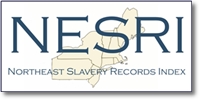Almost 3,000 enslaved people fled their enslavers and enlisted and fought in the Revolutionary War on the British side. Of the estimated 5,000 Black soldiers who enlisted on the Continental side, many had been enslaved, and joined to earn their freedom or were enlisted as substitutes for their enslavers. We have indexed 454 British-side and 3,830 Continental-side records from the northeast states (ME, NH, VT, MA, CT, RI, NY and NJ) in the NESRI database. Of the 3,830 Continental soldiers, we have verified that 397 were enslaved, but the status of many others is yet to be determined.
The names of these soldiers appear in our Locality Reports. You can identify a place like the name of a Town or County or an entire state, and see a customized report of the enslavement records for the selected locality, including, in Section Four of the report, a list of enslaved soldiers from either side of the Revolutionary War. Generally, enslaved soldiers on the British side came from New York and New Jersey, and on the Continental side from Massachusetts, Maine, New Hampshire and Rhode Island.
British Enlistments
In 1775, The Earl of Dunmore, as the British Governor of Virginia, issued a proclamation urging enslaved people to join arms with the British: “I do hereby further declare all indented Servants, Negroes, or others, (appertaining to Rebels,) free that are able and willing to bear Arms, they joining His MAJESTY’S Troops as soon as may be, for the more speedily reducing this Colony to a proper Sense of their Duty, to His MAJESTY’S Crown and Dignity.”
In reply, the General Convention of the Dominion and Colony of Virginia threatened dire consequences: “WHEREAS Lord Dunmore, by his proclamation, dated on board the ship William, off Norfolk, the 7th day of November 1775, hath offered freedom to such able-bodied slaves as are willing to join him, and take up arms, against the good people of this colony, giving thereby encouragement to a general insurrection, which may induce a necessity of inflicting the severest punishments upon those unhappy people, already deluded by his base and insidious arts; and whereas, by an act of the General Assembly now in force in this colony, it is enacted, that all negro or other slaves, conspiring to rebel or make insurrection, shall suffer death, and be excluded all benefit of clergy.”
However, by 1778, colonies passed similar measures encouraging enlistment on the American side. For example, the Rhode Island Assembly passed a law encouraging “Every able bodied negro, mulatto, or Indian man slave” to enlist, receiving the same bounties and wages as any other Continental Army soldiers. The enslaved person, once enlisted, would be “…immediately discharged from the service of his master or mistress, and be absolutely free, as though he had never been encumbered with any kind of servitude or slavery.”
Documenting British-side Enlistments
Records of enslaved people who fought on the British side are based on passenger lists of ships, arranged through the Treaty of Paris that resolved the War, providing for these enslaved people to be emancipated for emigration to Canada.
Following the Treaty of Paris, which ended the Revolutionary War in 1783, the British forces gathered in New York to be evacuated. Congress instructed General George Washington to claim all confiscated property from the British, including enslaved people. However, the British commander-in-chief, Sir Guy Carleton, refused to comply with General Washington’s demand that the enslaved people be returned to their enslavers. The Treaty provided that the enslaved people would be permitted to emigrate and that the British would compensate their enslavers. The enslavers to be compensated included our first President, George Washington, for the fugitive soldier named Harry Washington, and our first Chief Justice of the Supreme Court, John Jay, for the fugitive soldier named Massey.
Documenting Enlistments on the American Side
Records of enslaved people who fought on the American side are based on a remarkable book, Eric G. Grundset, editor, Forgotten Patriots – African American and American Indian Patriots in the Revolutionary War: A Guide to Service, Sources, and Studies, (Daughters of the American Revolution, 2008), that attempts to list all of the Black and indigenous people who fought in the Revolutionary War, providing extensive documentation for each listed person, including the enslavement status of many of the Black soldiers. We have indexed this list for the NESRI states so that it can be accessed in the context of other records. Of the 3,830 Continental soldiers, we have verified that 397 were enslaved, but the status of many others is yet to be determined primarily because they may have been enslaved at the time of enlistment, but free at the time of the record involved.
The enslaved soldiers include Joseph Brown of South Kingston, Rhode Island, enslaved by Beriah Brown, who served as a substitute for Beriah’s son Christopher. Marlin Brown, enslaved by John Rooback of New York State, was denied a pension because he was a slave, according to record R6978 in the Revolutionary War Pension File in the National Archives and Records Administration. Tunis Brown and Cato, enslaved by William Rockafeller who served in Colonel Marinus Willett’s “Levies” in 1781. Rockafeller was paid nineteen pounds, sixteen shillings and five pence for the military service of Tunis Brown and twenty pounds sixteen shillings for the service of Cato.



